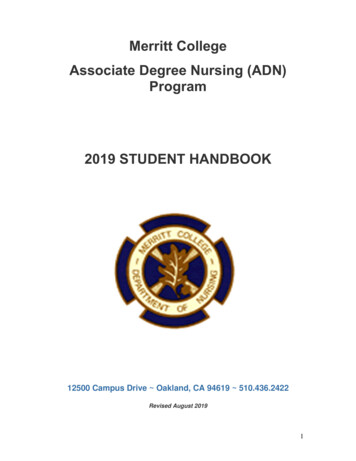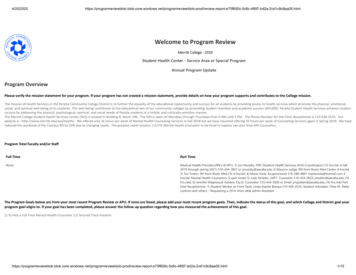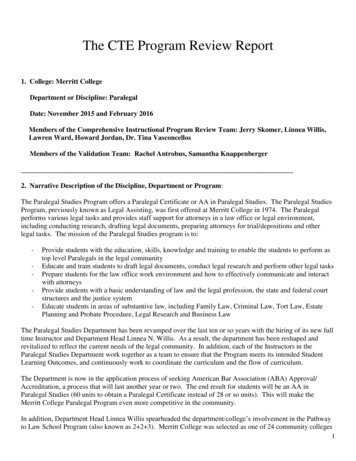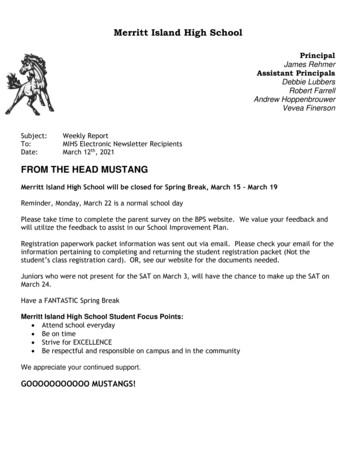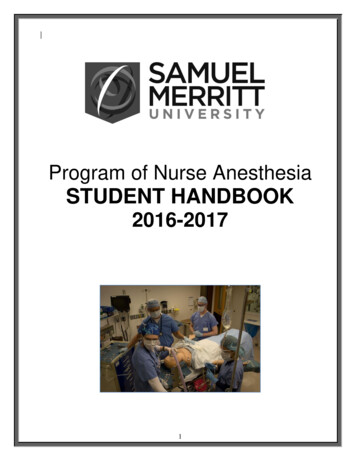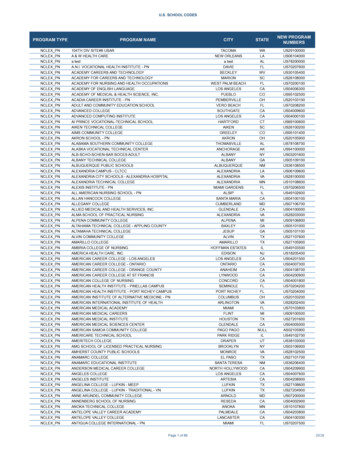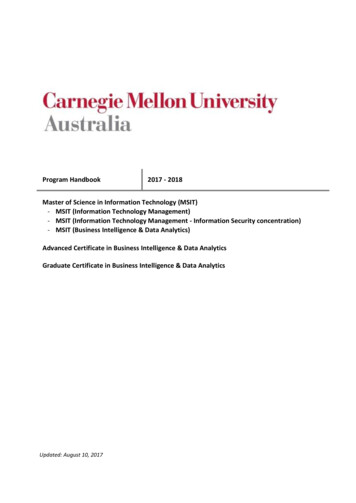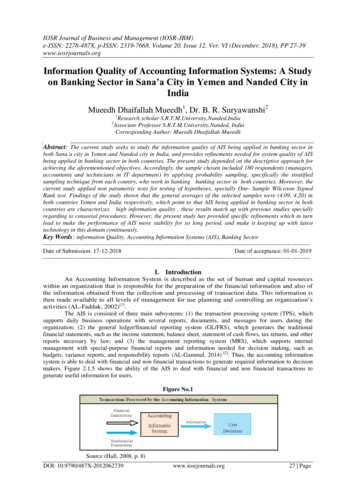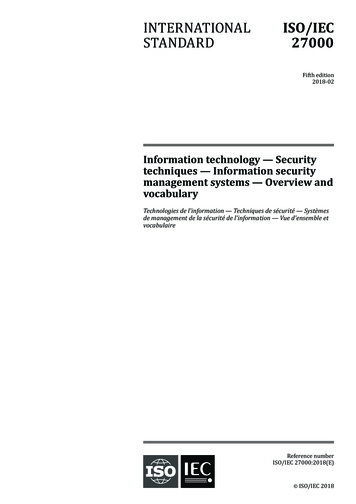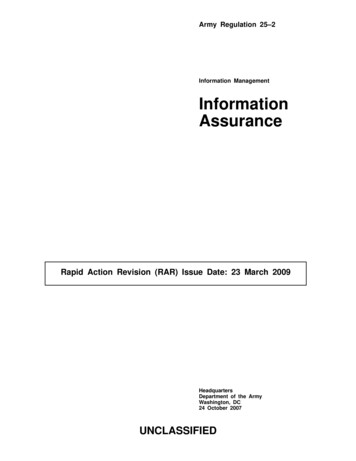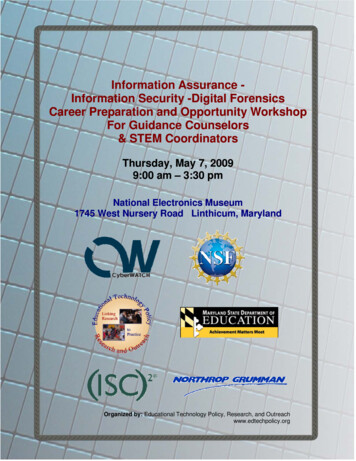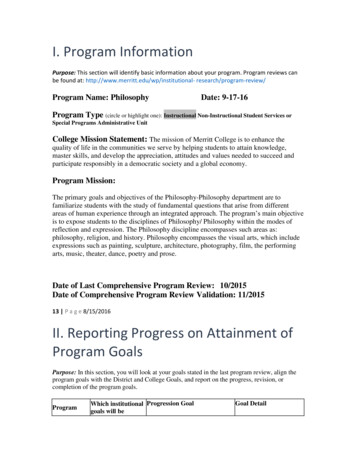
Transcription
I. Program InformationPurpose: This section will identify basic information about your program. Program reviews canbe found at: http://www.merritt.edu/wp/institutional- research/program-review/Program Name: PhilosophyDate: 9-17-16Program Type (circle or highlight one): Instructional Non-Instructional Student Services orSpecial Programs Administrative UnitCollege Mission Statement: The mission of Merritt College is to enhance thequality of life in the communities we serve by helping students to attain knowledge,master skills, and develop the appreciation, attitudes and values needed to succeed andparticipate responsibly in a democratic society and a global economy.Program Mission:The primary goals and objectives of the Philosophy-Philosophy department are tofamiliarize students with the study of fundamental questions that arise from differentareas of human experience through an integrated approach. The program’s main objectiveis to expose students to the disciplines of Philosophy/ Philosophy within the modes ofreflection and expression. The Philosophy discipline encompasses such areas as:philosophy, religion, and history. Philosophy encompasses the visual arts, which includeexpressions such as painting, sculpture, architecture, photography, film, the performingarts, music, theater, dance, poetry and prose.Date of Last Comprehensive Program Review: 10/2015Date of Comprehensive Program Review Validation: 11/201513 P a g e 8/15/2016II. Reporting Progress on Attainment ofProgram GoalsPurpose: In this section, you will look at your goals stated in the last program review, align theprogram goals with the District and College Goals, and report on the progress, revision, orcompletion of the program goals.ProgramWhich institutional Progression Goalgoals will beGoal Detail
Goal*Copy theGoalsReportedfrom(indicate date next to theadvanced uponcompletion? (PCCD appropriate status for the goal)and MC GoalMapping)(Describe how the goalwas met, or is still beingpursued. If a goal is newor revised, explain therevision.)ProgramReviewQuestion 10or AppendixB, or input therevised goal.Activity -- ongoing:Implement departmentwide dialog about1. PCCD Goal:assessment results tocommunication,improve learning andcritical thinking,strengthen teaching, tocultural awareness,prioritize actions.as well as civicComment: TheAssessmentengagement &Department has beenethicsengaged in ongoingNew Goal:assessment dialogue,DevelopD.3Completed:and has also begun toinquiry 10/2015 (date) deepen thesebased facultyD: Strengthendiscussions duringfocus groupsAccountability,department meetingsresponsibleInnovation andRevised:and through facultyforCollaboration9/16/16 (date)focus inquiry groups;examiningfunding from the Basicassignments,Skills Transformationalassessments,Ongoing:and results 2. Merritt Goal D ONGOING Grant will allow thedepartment to developon an(date)more opportunities forongoing,Through Collegial 9/16/16 (currentfaculty focus groups torigorous and governance,date)meet and discuss, plan,authenticsupportand reflect uponmanner.institutionalcurriculum, assessment,communication,and ongoing activitiesinnovation, andto support basic skillsinterdisciplinarystudents throughcollaboration.transfer.Revised Activity -Develop a 3-year 2year assessment plan
for the department toassess all outcomes forall courses as requiredby the College, andACCJC .Curriculum (ifapplicable)Reason for revision:By expanding theCompleted:different philosophy10/2015RevisedE: Develop andclasses offered, our(date)Goal:Manage Resourcesgoal is to attract moreExpand andto Advance Ourstudents to thestrengthenMissionphilosophy classesRevised:curriculum10/28/16 helping us to build thewith the2. Merritt(date)philosophy departmentintent ofGoaland broaden the currentincreasingphilosophy curriculum.retention,Ongoing:Create anThis will have theclassesenvironment made ONGOING effect of benefitting ouroffered and up of exceptional (date)students. The originalsuccess rates student access,goal does not specifyinequity, andhow the expansion ofphilosophy success.New Goal 9/16/16curriculum would(current date)classes.impact students.1. PCCDGoal: E.41. PCCDGoal: E.4Instruction (ifapplicable)New Goal:Secure adesignatedarea forEnglish withinstructionalsupplies tostrengthencollegial tiesbetweeninstructorsand improveDevelopand ManageResources Completed:to Advance 10/2015Our(date)MissionRevised:Activity: Create andpresent a proposal toFaculty Senaterequesting a designated9/16/16E.4 Support (date)area : ONGOING /English faculty focus(date)Increasegroups to meet.investments New Goal (currentinmaterials,equipment,andteaching
andlearningresources2. MerrittGoal Develophuman, fiscal, andtechnologicalresources toadvance andsustain ourmission.14 P a g e 8/15/2016date)Student Success and Student EquityGOAL: Our goal at MerrittCollege is to employ instructorswho are flexible enough whovalue and demonstrate multiculturalism in their teaching.And, the awareness of the facultymember in regards to the alreadymentioned elements defineshis/her ability as a caring,compassionate and a successfuleducator and communicator.Also, Create an environment ofexceptional student access, equity,and successProfessional Development,Institutional and ProfessionalEngagement, and PartnershipsActivity: We have hirea second Philosophy1. PCCDteacher who is trainedGoal: AMoodle and presentsdifferent philosophicalCompleted:A: Advanceperspectives and10/16/15Student Access,focuses on diverse(date)Equality andtopics involving race,Revised:Successclass, gender, veganism9/16/16gender bias and other2. Merritt Goal (date)topics that are of greatOngoing:interest to our diverseONGOING student population andCreate an(date)are gaining more focusenvironment ofNew Goal 9/16/16within academia. Theexceptionalmore variety offered in(current date)student access,class times, availabilityequality, andand topics covered wesuccess.feel will improvestudent success.1. PCCD Goal: BCompleted:10/16/15(date)Revised:9/16/16REVISED GOAL: To reach out to2.MerrittGoal(date)other community colleges bothOngoing:within and outside the peralta districtONGOINGto open dialogue about how toEngage ourimprove and expand our philosophy community through (date)department.respectful dialogue to New Goal 9/16/16B:Engage andLeverage PartnersProposed Activity: Ofall of the philosophydepartments within thePeralta district, MerrittCollege has the leastnumber of coursesoffered. It is theorizedthat an ongoingdiscussion betweenMerritt philosophyinstructors and
create partnershipsdepartment chairs mighhelp to improve andgrow Merritt’sphilosophy department(current date)Other GoalsCompleted:(date)Revised:1. PCCD Goal:(date)2. Merritt N/AOngoing:Goal N/A(date)New Goal (currentdate)15 P a g e 8/15/2016III. Data Trend AnalysisPurpose: In this section, you will report, review and reflect on your program data sincethe last program review (Fall 2015 and Spring 2016). You may copy and paste the tablesthat were provided to you in your data packet via email.Please review and reflect upon the data for your program that was sent via email.You will be asked to comment on significant changes in the data and/or achievementgaps. Focus upon the most recent academic year and/or the years since your lastcomprehensive program review. *If you have questions or concerns regarding yourdata, please contact Samantha Kessler, Research and Planning Officer:skessler@peralta.edu.Student Enrollment Demographics:(Copy/paste enrollment tables from data file)A. Student Demographics (headcount)TOTALFemaleMaleAge 20Age 20-24Age 25-39Age 40Fall 201438191982253Fall 2015452025525114Fall % Chg18.4%5.3%31.6%-37.5%13.6%120%33.3%Spring 201541162392093
African AmericanAmerican Indian/AlaskanAsianHispanicPacific IslanderWhiteTwo or more 200%33.3%-100%12061105431. What changes have occurred in enrollment since 2015-2016 program review?Overall there was growth in all demographic groups with the exception of studentswho are under 20 between fall 2014 and fall 2015, but by spring 2016 thisdemographic group had grown by 22%. Also, Asian students decreased in number byabout -33% between fall 2014 and fall 2015, but by spring 2016 growth was up 22%according to this table.Student Enrollment Demographics:(Copy/paste enrollment tables from data file)B. EnrollmentTOTALSectionsCourse EnrollmentProductivityFall 201413819Fall 201514522.5Fall % Chg0%18.4%18.4%What changes have occurred in enrollment since 2015-2016 program review?Generally there seems to be a very slight decrease in students who were enrolledin Merritt College’s only philosophy class by only one student.Course Sections and Productivity: (Copy/paste Fall 15 and Spring 16 tablesfrom data file) ***Is this the right table here?***Spring 201514120.5
B. EnrollmentTOTALSectionsCourse EnrollmentProductivityB. EnrollmentFall 2014138Fall 201514519Fall % Chg0%18.4%1. Please comment on changes that have occurred in productivity since the 20152016 program review. (e.g. increase, decrease or no change)According to the data provided on this chart, there seems to be little change since the2015-2016 program review, again only one student less in the only English class that weoffer at Merritt College.Student Success: (copy/paste the course retention and course (successful) completiontables.C. Student SuccessFall 2014TOTALCourse Completion Rate*0.89Course Success Rate**0.63* A,B,C,D,F,W, P,NP, CR, NCR** A,B,C,P, CRFall 20150.910.531. Describe the course retention and successful course completion rates and anychanges since the 2015-2016 program review. (Note: Course retention is the %of students who finish the course – any grade other than W. Successful coursecompletion is the % of students earning a grade C or better in the course.)The overall retention rate in the one Philosophy course we offer heldconsistent between fall 2015 and spring 2016 at about 91%.Spring 2015141
Student Success in Distance Education/Hybrid classes versus face-toface classes: (copy/paste the Distance Ed retention and course completion datahere.)D. Student Success in DE/Hybrid, Face-to-FaceTOTAL100% DEHybrid100% Face-to-FaceFall 2014000.63Fall 2015000.53Fall % Chg00-0.1Philosophy Online (not yet, implemented, but pending)College course completion standard NO DATA AVAILABLEPlease insert the data chart here or complete the section below.Department/discipline Distance Education (100% online) course completion rates:Course1. Philosohpy I(course name and number)Course 2. . (course name and number)Course 3. . (course name and number)Course 4. . (course name and number)ETC. Discussion:16 P a g e 8/15/20161. Describe any difference in the Retention and Success of face-to-face anddistance education courses. Generally, speaking the retention and successrate of students in face-to-face classes was at least 10% higher than studentswho were enrolled in the hybrid classes.Spring 2015000.71
Other program specific data. Other data could include: departmentalresearch via survey or special projects that significantly supports the goals orfuture plans for the program.The answer to the previous question is impossible to answer given that currently there are no online orhybrid philosophy classes offered at Merritt College. Again, we have hired an additional philosophyteacher in the hopes that she will help grow the department by teaching in person, as well as hybridphilosophy classes, but as of the time of this review, there was only the 100% in person class offered.Course Sections and Productivity: (Copy/paste Fall 15 and Spring 16 tablesfrom data file)F. Degree/Certificate awardedTOTALAssociate DegreeCertificate2014-150002015-160001-Yr %change0%0%0%1. Please comment on changes that have occurred in productivity since the 20152016 program review. (e.g. increase, decrease or no change) Currently, productivity hasstayed mostly the same. ** No significant increases have been made.Student Success: (copy/paste the course retention and course (successful) completiontables.C. Student SuccessFall 2014TOTALCourse Completion Rate*0.89Course Success Rate**0.63* A,B,C,D,F,W, P,NP, CR, NCR** A,B,C,P, CRFall 20150.910.531. Describe the course retention and successful course completion rates and anychanges since the 2015-2016 program review. (Note: Course retention is theE55
% of students who finish the course – any grade other than W. Successfulcourse completion is the % of students earning a grade C or better in thecourse.)In spring 2015 the course completion rate was about 80% while in spring 2016 thecompletion rate had risen to about 91%, a difference of about 11%.Student Success in Distance Education/Hybrid classes versus face-toface classes: (copy/paste the Distance Ed retention and course completion datahere.)D. Student Success in DE/Hybrid, Face-to-FaceTOTAL100% DEHybrid100% Face-to-FaceFall 2014000.63Fall 2015000.53Fall % Chg00-0.116 P a g e 8/15/20161. Describe any difference in the Retention and Success of face-to-face anddistance education courses.As there is only one philosophy course that is offered at Merritt College currently,and it is a “face-to-face” class, there is no other class to compare it to, sowhether the course is online at or not seems to be a moot point in terms ofretention. Once Merritt College is able to offer in-person classes, as well as onlinecourse, then there will be more of a basis for comparison. That said, the single “face-to-face” philosophy class frequently fills up with students during mostsemesters. But as for the difference in the retention and success of ace-to face anddistance education course, the answer is 0%.IV. Aligning Program Goals, Activitiesand PlanningPurpose: In this section, you will align your program, department or unit goals with theEducational Master Plan goals. You will also be asked to comment on how yourSpring 2015000.71
department, unit or program is helping the College to achieve the targets set by theEquity, SSSP and Basic Skills Plans.1. Educational Master Plan Alignment: Please use the following matrix to demonstratehow your program goals align with the 2015-2020 Educational Master Plan Goals.2015-2020 EMP GoalsFoundations:1. Assess students’ strengths and needs thoroughly to accelerate completion ofcertificates, degrees and transfer readiness.2. ndtransfer.3. Establish an organizational structure that promotes coordination, innovation, andaccountability, and which embeds basic skills development across thecampus.Career Technical Education:1. Develop opportunities for CTE students to engage in campus and communityexperiences that enhance learning and student success (program-levelclubs/enterprises, activities that develop soft skills, etc.) by contextualizing andproactively engaging students.2. Create a Merritt-wide infrastructure that streamlines and develops employerpartnerships, including offering High quality internships, serving on advisory boards, andengaging in curriculum development.3. Strengthen Merritt College’s “on ramps” to our CTE pathways by enhancing distanceeducation, dual enrollment, adult education, contract education, etc., and providedifferentiated supports that ensure student success for targeted population.4. Create proactive strategies to engage faculty, students, and employers to supportprogram success and sustainability that increase student-level academic and careeroutcomes.Transfer:1. Establish fully functioning transfer center.2. Acquire more and better data (Higher granularity) on transfer rates. Collect transferdata to include UC, State, and Private institutions.3. Augment and strengthen specific partnerships with academic departments in CSUs, UCs,and private s to develop transfer pipelines.4. Augment and strengthen support services for transfer students campus-wide.5. Augment and strengthen support for transfer students within academic programs.18 P a g e
8/15/2016Directions: 1) input your program and department goals. 2) Identify which area of the EdMaster Plan this Goal aligns to – Foundations, Transfer and/or CTE. 3) Identify the goalnumber in that area the department goals aligns to. (Goal 1-5) 4) Describe the activitiesyour department or program will complete to meet the goal. 5) What standard or goal doyou think the activities will help the college achieve as a measurable outcome(Completion rate, degree/cert completion, transfer, remedial rates). Place and X in thestandard(s) and/or goal(s) your program activity will impact.How does this goal or the program activities align with the Educational Master Plan StrategicDirections and Goals? Our program goal is to continue to try to grow the department by:hiring additional philosophy instructors, creating more philosophy courses for the students,and making sure to offer philosophy classes at night to better serve the Merritt studentpopulation.Measurable Outcomes: Institution Set Standards and IE GoalsProgram/ department or unit GoalSuccessful Course Completion RateRetention Rate (F to F Persistence)Degree or Cert. CompletionRemedialRemedial Rate English (Basic Skills Success)TransferRate Math (Basic Skill Success)Example: 1. Assess annually a minimum of 1 SLO per regularly taught course2. Assess PLO’s on a three year cycle3. Align all recently taught courses with ILO’s4. Continue to engage in campus wide dialogue around assessment.Goal 1In our assessment process, we arecontinually assessing and making changes based on student performance and feedback toensure CTE students engagement in experiences that enhance learning and student success.X
xXX2. Student Equity, Student Success and Support Program (SSSP), and Basic Skills TargetGroups: These plans analyzed student success outcomes and disproportionately impactedstudent populations. The chart below outlines the results of this analysis, and is asummary of the student populations and focused outcomes that the College indicated itwould like to increase as a result of the Student Equity Plan (E), SSSP Plan (S), andBasic Skills Plan (B).a. As a program, department or unit, review your data and describe any activities you aredoing to address student equity gaps and special populations in the table below. Describethe target or focused student population, the problem/observation, theactivity/intervention, and the intended outcome. How does your activity align with theCollege’s Equity, SSSP and Basic Skills Goals19 P a g e 8/15/2016Foundations Transfer CTE(list the target group and indicator in the last box below)? In your description, please noteif the activity or intervention was funded by one of these grants in the past academic year(15-16).Answer: Currently, we will be offering a second section of philosophy class for adultstudents who can only attend classes in the evening due to having work commitmentsduring the daytime. The class will meet once a week on Tuesday evenings from 6p.m. 8:50p.m. We hope this class will better serve the students in our college community whoalso have childcare issues during the day, and can only attend class at night.2015-16 Student Equity Plan, Student Success and Support Program Plan(SSSP), and Basic Skills Goal Summary*S SSSP, E EQUITY, B BASIC SKILLS20 P a g e8/15/2016Directions: 1) Describe a challenge, achievement gap or observation you made in yourprogram data. 2) Describe an activity or intervention your program does to address thedata. 3) Note which student populations this activity or intervention targets. 4) describethe intended measurable outcome of the activity. Think about which indicator, from the
summary chart be
Date of Comprehensive Program Review Validation: 11/2015 13 P a g e 8/15/2016 II. Reporting Progress on Attainment of Program Goals Purpose: In this section, you will look at your goals stated in the last program review, align the program goals with the District an
